 |
BBNS511S-BIOLOGY FOR NATURAL SCIENCE-1ST OPP JUNE 2024 |
 |
1 Page 1 |
▲back to top |
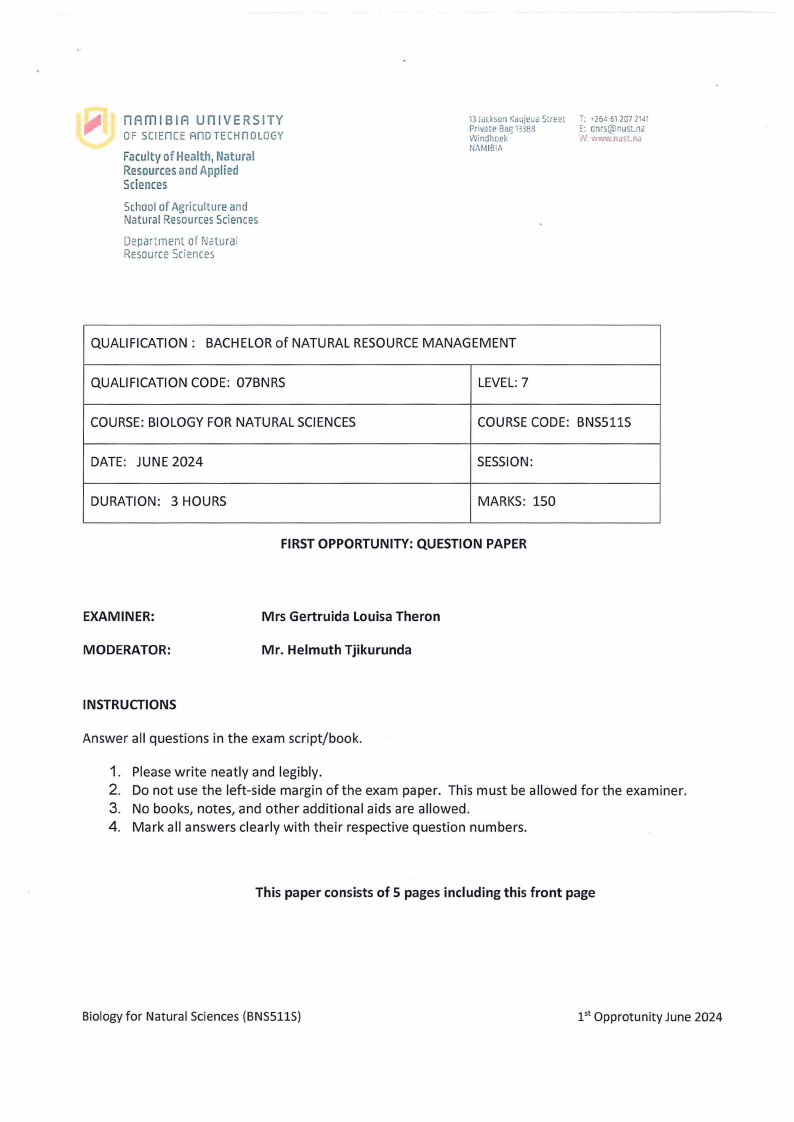
nAmIBIA UnlVERSITY
OF SCIEnCE AnDTECHnOLOGY
Faculty of Health, Natural
ResourceasndApplied
Sciences
Schoolof Agriculture and
NaturalResourcesSciences
Depar ment of Natural
ResourceSciences
13lucksonKaujeuaStreet
Private Bagi3l8B
Windl1oek
N1\\MIBIA
T: •264 61 20i 2141
E: dnrs@nust.na
W. 1·1v11·1.nust.nil
QUALIFICATION: BACHELOR of NATURAL RESOURCEMANAGEMENT
QUALIFICATION CODE: 07BNRS
LEVEL: 7
COURSE: BIOLOGY FOR NATURAL SCIENCES
DATE: JUNE 2024
COURSE CODE: BNSSllS
SESSION:
DURATION: 3 HOURS
MARKS: 150
FIRST OPPORTUNITY: QUESTION PAPER
EXAMINER:
MODERATOR:
Mrs Gertruida Louisa Theron
Mr. Helmuth Tjikurunda
INSTRUCTIONS
Answer all questions in the exam script/book.
1. Pleasewrite neatly and legibly.
2. Do not use the left-side margin of the exam paper. This must be allowed for the examiner.
3. No books, notes, and other additional aids are allowed.
4. Mark all answers clearly with their respective question numbers.
This paper consists of S pages including this front page
Biology for Natural Sciences (BNS511S)
1st Opprotunity June 2024
 |
2 Page 2 |
▲back to top |
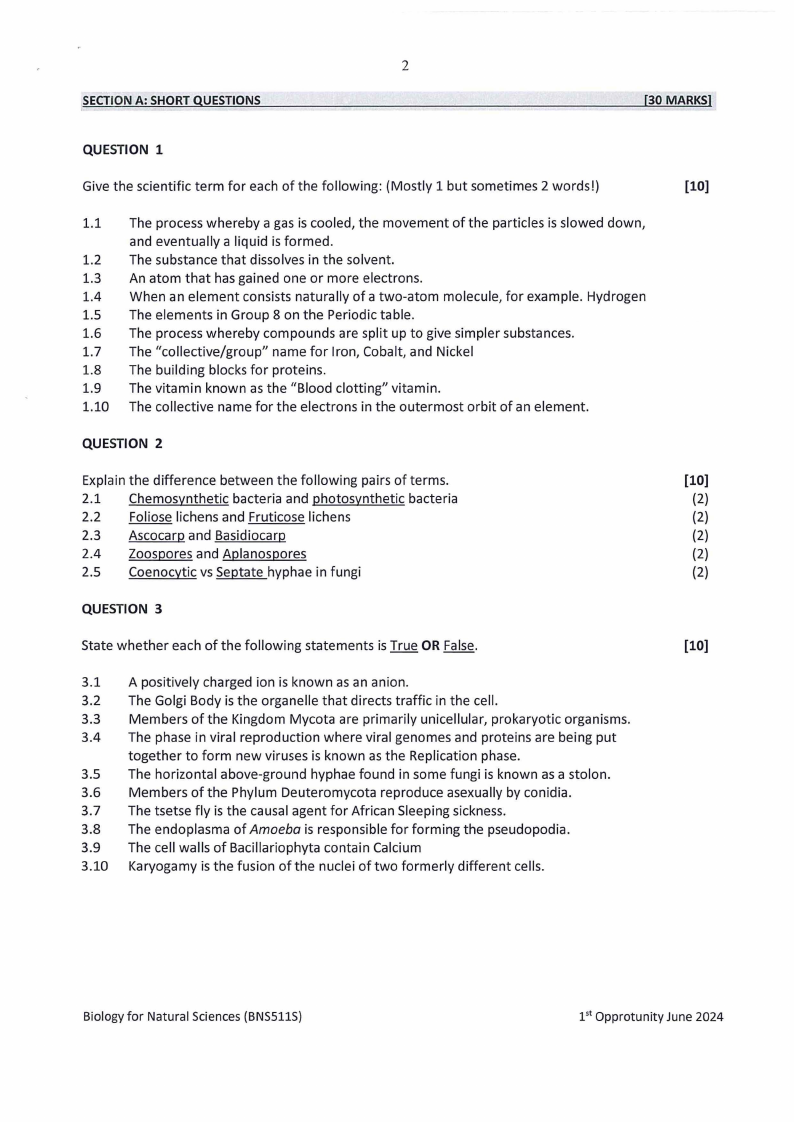
2
SECTIONA: SHORTQUESTIONS
[30 MARKS]
QUESTION 1
Give the scientific term for each of the following: {Mostly 1 but sometimes 2 words!)
(10]
1.1 The process whereby a gas is cooled, the movement of the particles is slowed down,
and eventually a liquid is formed.
1.2 The substance that dissolves in the solvent.
1.3 An atom that has gained one or more electrons.
1.4 When an element consists naturally of a two-atom molecule, for example. Hydrogen
1.5 The elements in Group 8 on the Periodic table.
1.6 The process whereby compounds are split up to give simpler substances.
1.7 The "collective/group" name for Iron, Cobalt, and Nickel
1.8 The building blocks for proteins.
1.9 The vitamin known as the "Blood clotting" vitamin.
1.10 The collective name for the electrons in the outermost orbit of an element.
QUESTION 2
Explain the difference between the following pairs of terms.
(10]
2.1 Chemosynthetic bacteria and photosynthetic bacteria
(2)
2.2 Foliose lichens and Fruticose lichens
(2)
2.3 Ascocarp and Basidiocarp
{2)
2.4 Zoospores and Aplanospores
{2)
2.5 Coenocytic vs Septate hyphae in fungi
{2)
QUESTION 3
State whether each of the following statements is True OR False.
(10]
3.1 A positively charged ion is known as an anion.
3.2 The Golgi Body is the organelle that directs traffic in the cell.
3.3 Members of the Kingdom Mycota are primarily unicellular, prokaryotic organisms.
3.4 The phase in viral reproduction where viral genomes and proteins are being put
together to form new viruses is known as the Replication phase.
3.5 The horizontal above-ground hyphae found in some fungi is known as a stolon.
3.6 Members of the Phylum Deuteromycota reproduce asexually by conidia.
3.7 The tsetse fly is the causal agent for African Sleeping sickness.
3.8 The endoplasma of Amoeba is responsible for forming the pseudopodia.
3.9 The cell walls of Bacillariophyta contain Calcium
3.10 Karyogamy is the fusion of the nuclei of two formerly different cells.
Biology for Natural Sciences (BNS511S)
i5t Opprotunity June 2024
 |
3 Page 3 |
▲back to top |
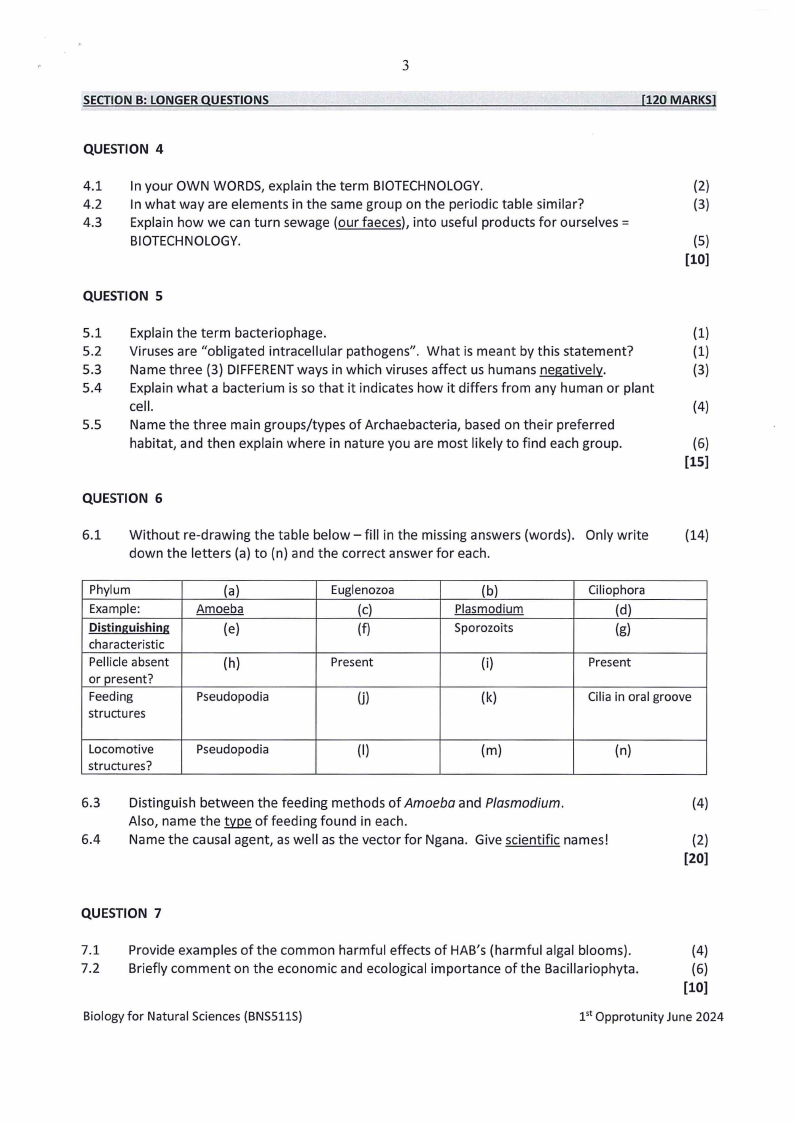
3
SECTIONB: LONGERQUESTIONS
[120 MARKS)
QUESTION 4
4.1 In your OWN WORDS, explain the term BIOTECHNOLOGY.
(2)
4.2 In what way are elements in the same group on the periodic table similar?
{3)
4.3 Explain how we can turn sewage {our faeces), into useful products for ourselves=
BIOTECHNOLOGY.
(5)
[10)
QUESTION 5
5.1 Explain the term bacteriophage.
5.2 Viruses are "obligated intracellular pathogens". What is meant by this statement?
5.3 Name three (3) DIFFERENTways in which viruses affect us humans negatively.
5.4 Explain what a bacterium is so that it indicates how it differs from any human or plant
cell.
5.5 Name the three main groups/types of Archaebacteria, based on their preferred
habitat, and then explain where in nature you are most likely to find each group.
{1)
(1)
(3)
(4)
(6)
[15)
QUESTION 6
6.1 Without re-drawing the table below - fill in the missing answers {words). Only write
{14)
down the letters {a) to {n) and the correct answer for each.
Phylum
Example:
Distinguishing
characteristic
Pellicle absent
or present?
Feeding
structures
{a)
Amoeba
{e)
{h)
Pseudopodia
Euglenozoa
{c)
{f)
Present
{j)
{b)
Plasmodium
Sporozoits
{i)
{k)
Ciliophora
{d)
{g)
Present
Cilia in oral groove
Locomotive
Pseudopodia
{I)
{m)
{n)
structures?
6.3 Distinguish between the feeding methods of Amoeba and Plasmodium.
(4)
Also, name the !YQg of feeding found in each.
6.4 Name the causal agent, as well as the vector for Ngana. Give scientific names!
(2)
[20)
QUESTION 7
7.1 Provide examples of the common harmful effects of HAB's {harmful algal blooms).
(4)
7.2 Briefly comment on the economic and ecological importance of the Bacillariophyta.
{6)
[10)
Biology for Natural Sciences (BNSSllS)
i5t Opprotunity June 2024
 |
4 Page 4 |
▲back to top |
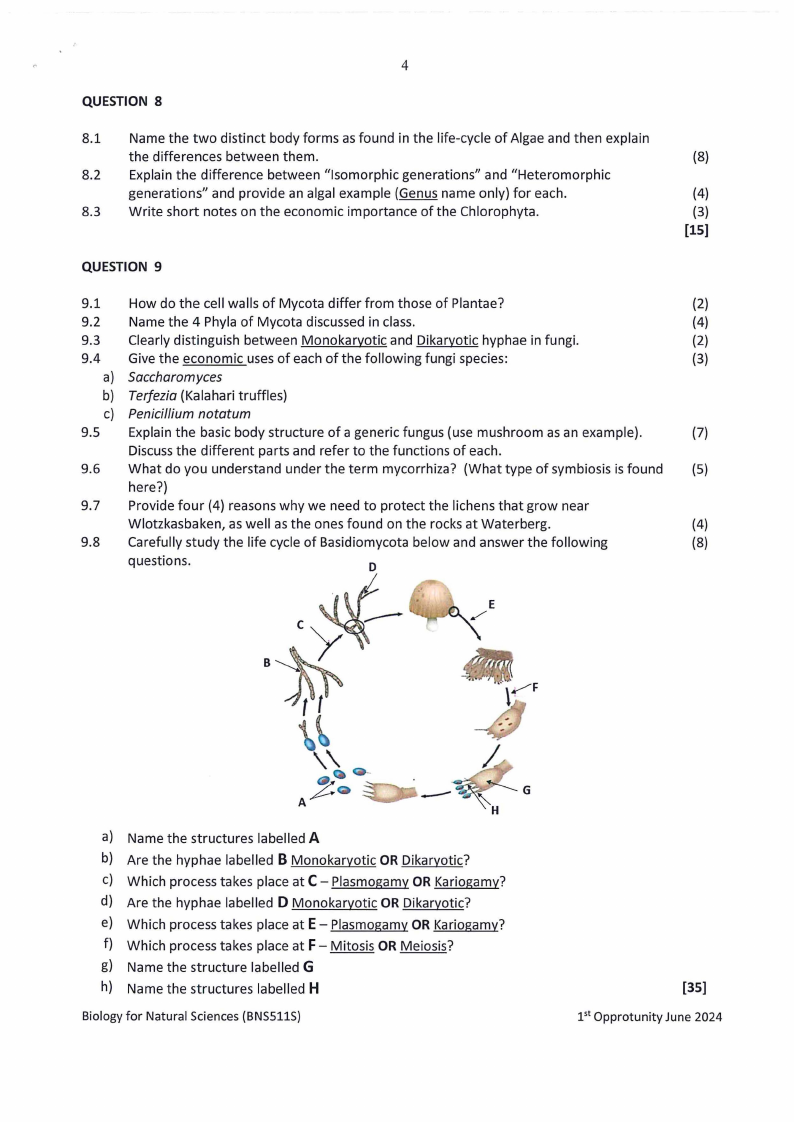
4
QUESTION 8
8.1 Name the two distinct body forms as found in the life-cycle of Algae and then explain
the differences between them.
(8)
8.2 Explain the difference between "Isomorphic generations" and "Heteromorphic
generations" and provide an algal example (Genus name only) for each.
(4)
8.3 Write short notes on the economic importance of the Chlorophyta.
(3)
[15]
QUESTION 9
9.1 How do the cell walls of Mycota differ from those of Plantae?
(2)
9.2 Name the 4 Phyla of Mycota discussed in class.
(4)
9.3 Clearly distinguish between Monokaryotic and Dikaryotic hyphae in fungi.
(2)
9.4 Give the economic uses of each of the following fungi species:
(3)
a) Saccharomyces
b) Terfezia (Kalahari truffles)
c) Penicillium notatum
9.5 Explain the basic body structure of a generic fungus (use mushroom as an example).
(7)
Discussthe different parts and refer to the functions of each.
9.6 What do you understand under the term mycorrhiza? (What type of symbiosis is found (S)
here?)
9.7 Provide four (4) reasons why we need to protect the lichens that grow near
Wlotzkasbaken, as well as the ones found on the rocks at Waterberg.
(4)
9.8 Carefully study the life cycle of Basidiomycota below and answer the following
(8)
questions.
D
-~c~
J~,r%
G
a) Name the structures labelled A
b) Are the hyphae labelled B Monokaryotic OR Dikaryotic?
c) Which process takes place at C- Plasmogamy OR Kariogamy?
d) Are the hyphae labelled D Monokaryotic OR Dikaryotic?
e) Which process takes place at E- Plasmogamy OR Kariogamy?
f) Which process takes place at F- Mitosis OR Meiosis?
g) Name the structure labelled G
h) Name the structures labelled H
Biology for Natural Sciences (BNS511S)
[35]
i5t Opprotunity June 2024
 |
5 Page 5 |
▲back to top |
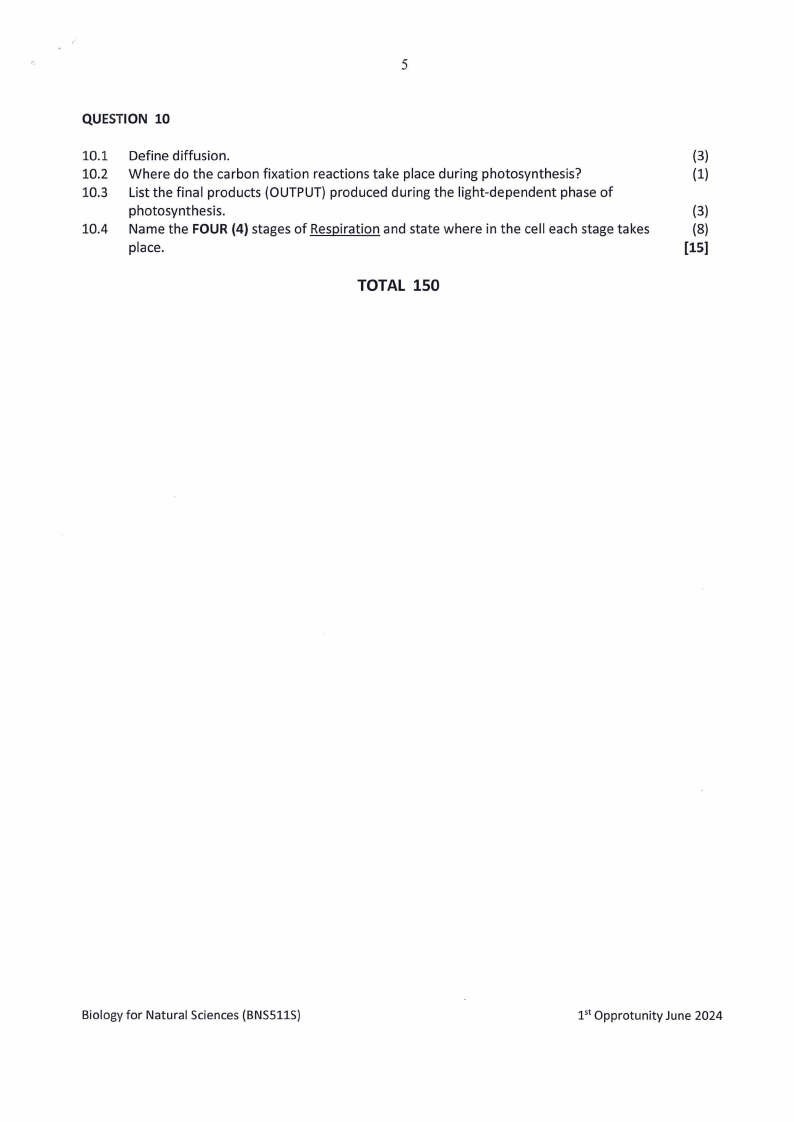
5
QUESTION 10
10.1 Define diffusion.
(3)
10.2 Where do the carbon fixation reactions take place during photosynthesis?
(1)
10.3 List the final products (OUTPUT)produced during the light-dependent phase of
photosynthesis.
(3)
10.4 Name the FOUR (4) stages of Respiration and state where in the cell each stage takes
(8)
place.
[15]
TOTAL 150
Biology for Natural Sciences (BNSSllS)
1'1 Opprotunity June 2024





